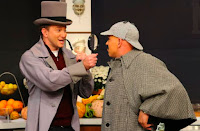Ok, no, I'm not in a monks robe, secretly writing this from a six by ten room with only a small table, a cot and a slit window. By candlelight. But I could be.
I was, admittedly, trying to get your attention. Thanks for your cooperation. So, imagine! It's the 18th century and this is your day to day existence, it's how you live. Everyday. Uniquely though, when you aren't in your room meditating, you're making some of the best beer the world has ever seen due to the fact that the monastery where you live has been making it the same way for 100's of years. We're talking, really really good beer. Now do I have your attention? Excellent. Let's talk Belgian beer.
Interestingly enough, at this stage of my life, beer used to be my last choice when consuming a beverage with a meal. Not anymore. There was a time, in my culinarily uneducated youth, when American pilsners and lagers were my beers of choice. No offense meant,
king of beer drinkers. I'm simply relating
my experience. I'll still share a frosty cold, mountain brewed, born on date, lite something or other with ya anytime you want. I love NASCAR. Seriously. "Hey, if we can get that train that turns into a really cool
bar car, that would be awesome dude, Lets do that...!"
There was also a '
looking at the tropical blue waves through my feet, with a lime in it," phase. The lime was in my beer....not my feet. Grow up. I hung around at the beaches of southern tropical points unnamed, in cargo shorts and Cuba
vera shirts and everything was 'cool, mon.' Me...and my
decorated for Christmas palm tree.
Now, I'd like to think I am adventurous. In life, but especially, when it comes to trying new cuisines. Adventurous type people's tastes and preferences seem to evolve and we go through what I like to call phases. Think about most adventurers you know, either personally or famous. We always have a next project, or new thing we're into, right? Phases, lol. It doesn't mean we move off of any one thing or another, or that we even like something less. It's that we are seeking new challenges, tastes and experiences. For most, the inquisitive mind and palate is a blessing
and a curse. It loves new adventure, but is never satisfied and can sometimes loath familiarity. It searches. It can get you in trouble, or it can lead to oft times wonderful experiences. Either way, it's always interesting, And, when it's interesting, now and again folks like me write about it. It creates moments, memories. It's also a good thing, in that there is never a want for topics for the inquisitive mind. Currently, this taste evolution has happened to me with regard to beer. On my beer journey, I discovered and have taken a shine to Belgian ales.
I was given a few, hard to get, bottles of Belgian Ale, which are now relegated to my hard to get
, empty bottles of Belgian ale' and I decided I needed to know more about them........the ales...not the bottles. I, in my usually obsessively compulsive way, started doing research. Now I'm a doer so there was no
just reading. 
Well, ok, there was a lot of
just reading, but I was convinced that just interviews and research was not enough. I was going to be
interactive with my story. I thought about traveling to Belgium and going to the monastic breweries, but then realized that while on my bucket list, at the time of this writing, it was out of the question. First, everybody knows that trying to score a good
Belgian Beer Route map late on a Wednesday night is almost impossible because all the best beer map dealers are bowling. Second, as it was Wednesday night, Ghosthunters was on at nine. So, sans backpack and map, I went to a local beer specialty store, and bought as many varied bottles of different Belgian ales as I could find. I bought every style, flavor and brand. I would taste them and write while I tasted. I wanted to be thorough, so I bought 20 different kinds, from the inexpensive to the very expensive. A lot of bottles.
Too many bottles.
A groggy day and a half later, after having a meeting with myself, I decided maybe I should forego the writing
and tasting at the same time and concentrate on just the writing. Here's what I came up with.
Belgian Ales
Belgian beer comprises one of the most diverse national collections of any quality beer in the world. It is a wide ranging industry, producing the popular pale lager, lambic beers and Flemish Reds. Beer-brewing origins here, it is said, go back to the Middle Ages and there are approximately 175+ breweries in the country at last count. In Europe, only Germany, France and the United Kingdom are home to more. Belgian breweries produce about 500 standard beers and if you include special one-off beers, the total number of Belgian beers is approximately 8700! That's right, 8700. Think about how much beer has to be consumed to keep all these brands viable and, since it is a perishable product, most of the beer that is made in small batches, is usually consumed within days of its creation. It also means that the rest of us are mere beer
neophytes, or at least I am, when compared to the fact that Belgians drink 24 gallons (93 litres) of beer per year, per person, on average. Furthermore, they've been perfecting this process for 100's of years. It is believed today that beer was brewed at some monasteries during the Middle Ages, however no written proof exists. What is known, is that the monks were living in the Trappist monasteries, brewing beer in Belgium for themselves alone in the late 18th century and sometime in June 1861, someone sold the first beer. A
brown beer. Thanks to whomever monk that was.
Trappist Beers

This term is properly applied only to a brewery in a monastery of the Trappists, one of the most severe orders of monks. This order, established at La Trappe, in Normandy, is a stricter observance of the Cistercian rule (from C'teaux, in Burgundy), itself a breakaway from the Benedictines. Among the dozen or so surviving abbey breweries in Europe, seven are Trappist, six being located in Belgium and they were all established in their present form by Trappists who left France after the turbulence of the Napoleonic period. The Trappists have the only monastic breweries in Belgium, all making strong ales, with a re-fermentation in the bottle. Some gain a distinctly rummy character from the use of candy-sugar in the brew-kettles. They do not represent a style, but rather are very much a family of beers. The three abbeys in the French-speaking part of the country, are all in the forest country of the Ardennes, where hermitages burned charcoal to fuel early craft industries. It is not usually possible to visit the abbeys without prior arrangement by letter, and can be difficult even then. Most offer their beers in a café or auberge/inn located nearby the actual monastery brewery itself.

In 1997, eight Trappist abbeys founded the International Trappist Association (ITA) to prevent non-Trappist, commercial companies from abusing the Trappist name. This private association created a logo that is assigned to goods (cheese, beer, wine, etc.) that respect precise Trappist production criteria. For the beers, these criteria are the following:
- The beer must be brewed within the walls of a Trappist abbey, by or under control of Trappist monks.
- The brewery, the choices of brewing, and the commercial orientations must depend on the monastic community.
- The economic purpose of the brewery must be directed toward assistance and not toward financial profit.
This association has a legal standing, and its logo gives to the consumer some information and guarantees about the produce. There are currently seven breweries that are allowed to have products wear the Authentic Trappist Product logo.
Abbey Bears
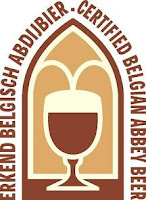
(Bières d’Abbaye or Abdijbier) are brewed by commercial brewers, and license their name from abbeys, some defunct, some still operating. Abbey beers mainly came into being following World War II when Trappist beers experienced a new popularity. The Abbey beers were developed to take advantage of the public's interest in the Trappist beers. This is why the single key component of an Abbey beer is its name: there is always the name of a monastery (either real or fictitious). Like the Trappist beers, Abbey beers do not connote a beer style, but rather a marketing term; however, since the purpose of Abbey beers is to imitate the Trappists, like the Trappists, most of their beers are either a dubbel or tripel.
The Brewing Monks
Monastic beers, as explained in our previous chapter are generally defined as beers referring to monks or to religious symbols. When they wear the name of an abbey, they are then called abbey beers.
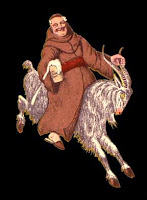
The Belgian monastic beers that we know today belong to a family of beers that appeared during the first quarter of the 20th century. Truly authentic monastic beers were created centuries ago, and some famous examples remain today, such as Mallersdorf and Andechs of Germany. Unfortunately, the number of authentic monastic breweries is rather limited today and the vast majority of the monastic/abbey beers that are available today have little or no direct links with monks or nuns. However, these abbey beers use the high secular reputation of genuine monastic beers to promote an image of tradition and quality.
The monks are often represented as jovial characters, very often corpulent, as to show the quality of the beer and its associated welfare. Images and names are carefully chosen to evoke values of tradition and know-how. The brewers, while paying homage to the work that was formerly carried out by the monks, try to suggest that their beer is the vehicle of these secular values of quality. Very often, these monastic beers see great success, sometimes becoming more famous than genuine monastic or Trappist beers they imitate. The fact that they are generally not brewed by the monks does not predict their quality. Some of them are indeed excellent beers .
Types of Belgian Beer
Abbey Ales (Dubbel, Tripel, Singel).
Altbier
Belgian Style Golden Ale
Belgian Style Strong Ale
Belgian Style Red Ale
Belgian Style Amber Ale
Belgian Style Blonde Ale
Biere de Garde
Flemish Style Brown Ale
Kolsch
Saison
Trappist Ale
The Trappist order originated in the Cistercian monastery of La Trappe, France. Various Cistercian congregations existed for many years, and by 1664 the Abbot of La Trappe felt that the Cistercians were becoming too liberal. He introduced strict new rules in the abbey and the Strict Observance was born. Since this time, many of the rules have been relaxed. However, a fundamental tenet, that monasteries should be self-supporting, is still maintained by these groups.
Monastery brew-houses, from different religious orders, existed all over Europe, since the middle-ages. From the very beginning, beer was brewed in French cistercian monasteries following the Strict Observance. For example, the monastery of La Trappe in Soligny, already had its own brewery in 1685. Breweries were only later introduced in monasteries of other countries, following the extension of the Trappist order from France to

the rest of Europe. The Trappists, like many other religious people, originally brewed beer to feed the community, in a perspective of self-sufficiency. Nowadays, Trappist breweries also brew beer to fund their works, and for good causes. Many of the Trappist monasteries and breweries were destroyed during the French Revolution and the World Wars. Among the monastic breweries, the Trappists were certainly the most active brewers: in the last 300 years, there were at least eight Trappist breweries in France, six in Belgium, two in the Netherlands, one in Germany, one in Austria, one in Bosnia and possibly other countries. Today, six Trappist breweries remain active, in Belgium.
The Breweries
Brasserie d'Orval  Founded: 1931
Founded: 1931
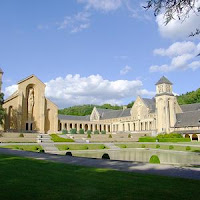
The most singular of the Trappist brewing abbeys, in both its architecture and its beer. The name derives from Vallée d'Or ("Golden Valley"). Legend has it that Countess Matilda of Tuscany (c1046-1115) lost a gold ring in the lake. When it was brought to the surface by a trout, she thanked God by endowing a monastery. The monastery, was certainly brewing before the French Revolution. Bread and cheese are made for sale, as well as a startlingly dry, hoppy, ale with an dark orange color. Devotees like to bottle-age this beer for between six months and three years.
Bières de Chimay  Founded: 1863
Founded: 1863
The best-known of the Trappist brewing monasteries. This abbey, also called Notre Dame, stands on a small hill called Scourmont, not far from the town of Chimay, also on the French border, but in the province of Hainaut. Originally a glass-smelting town, Chimay is now a center for tourism in the Ardennes. The abbey, in the Romanesque style, was built in 1850. While the early abbeys brewed for their own communities, Chimay was the first to sell its beer commercially. Between the two World Wars, it coined the appellation "Trappist Beer." After World War II, Chimay's great brewer Father Théodore, worked with a famous Belgian brewing scientist Jean De Clerck to isolate the yeasts that identified Chimay's beers as classic Trappist brews. The strongest will mature in the bottle for at least five years. It makes an excellent accompaniment to Chimay's Trappist cheese (similar to a Port Salut) and is even better with Roquefort.
Brasserie de Rochefort  Founded: 1595
Founded: 1595
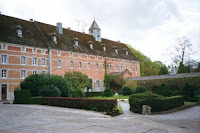
The least well-known of the established Trappist breweries. Notre Dame de St Rémy is near the small town of Rochefort, in the province of Namur, where the valley of the river Meuse rises into the Ardennes. In 1230, it was a convent, and brewed at least as early as 1595. The oldest parts of the buildings date from the 1600s. The beers, tawny to brown in color, have an earthy honesty, perhaps deriving from a quite simple formulation, in which dark candy sugar is a significant ingredient. They have flavors reminiscent of figs, bananas and chocolate. In recent years its 10-degree beer has won a growing appreciation. The abbey does not have its own inn, but the beers can be tasted locally at two local hotels: Limbourg (
also good for charcuterie and game), and the slightly more expensive, Malle Post.
Brouwerij Westvleteren  Founded: 1838
Founded: 1838
The smallest of the Trappist breweries, the abbey of St. Sixtus, at West Vleteren, near Ieper and Poperinge, dates from the 1830s. Its beers are not filtered or centrifuged at any stage of production, and emerge with firm, long, big, fresh, malty flavors and suggestions of plum brandy. The strongest ale has on occasion been rated the most potent beer in Belgium. The beers are available next door at the Café In De Vrede. Otherwise, trade and public alike have to go to a serving hatch at the abbey where a recorded phone message tells callers which beer will be available, and when. If the 12 is on sale, cars will begin lining up long before the 10 AM opening time in the morning. Each car is rationed to ten cases. The monks are inflexible on this point, even toward a café-owner who makes a 1,500-mile round-trip from say Odense, on the Danish island of Fynen. "We make as much beer as we need to support the abbey and no more," say the monks.
Brouwerij Westmalle  Founded: 1836
Founded: 1836

Famous for one beer in particular, a world classic, though its makes three. The abbey of Our Lady of the Sacred Heart is in flat countryside at West Malle, between the city of Antwerp and the Dutch border. The monastery was established in 1794, and has brewed since 1836. It is thus the oldest of Belgium's post-Napoleonic Trappist breweries. Its renown, though, derives from the introduction of golden Trappist ales to meet competition from fashionable Pilsners after World War II. Its beers include a marvelously subtle, golden "Single" (curiously called Extra), brewed at 4.0 per cent for the monks' own consumption, but sometimes also found outside the abbey; a dark-brown, fruity Dubbel, at 6.5; and its most famous beer, its golden-to-bronze, aromatic, orange-tasting, complex Tripel, at 9.0. These Trappist classics have popularized the notion that an "abbey-style Double" should be strong and dark and a "Triple," yet more potent, but pale. The beers are available in the village at the café Trappisten.
Brouwerij de Achelse Kluis  Founded: 1998
Founded: 1998
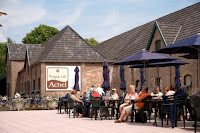
Brewing is being revived, on a small scale, at this sixth Trappist abbey, in Belgium, but close to the Dutch city of Eindhoven. The abbey had a brewery before World War II. In 1998, it opened a small pub initially selling Westmalle, prior to making its own beer. This positive step came at a time of less happy news from across the border, where the Koningshoeven abbey was considering consigning its Schaapskooi brewery, producer of the La Trappe ales, to a joint venture with a large, commercial lager-maker.
A Beer of Note
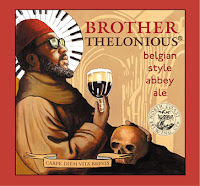 Brother Thelonious
Brother Thelonious
Belgian Style Abbey Ale
This abbey ale, it holds a special place in my heart because of its roots to the father of Jazz, Thelonius Monk. From a jazz blues background I loved the label, and the beer is quite good to boot. Like a Belgian “Dark Strong Ale”, the beer is rich and robust with an ABV of 9.3%. The package is a 750 ml bottle with a traditional cork and wire finish or 12oz 4 packs and features a label picturing the jazz master himself. Vital Statistics: Style: Belgian Style Strong Dark Color: Dark mahogany ABV: 9.4%, Bitterness: 32

IBU's
While I am certainly no expert when it comes the subtleties and nuances of beer and ale, my hope is that, this article will start you on your way to experiencing and experimenting with Belgian ales. Beer tastings and pairings are becoming more and more popular, and in summer, these can be a refreshing alternative to the more widely known wine pairings. Below is a picture of my bottle of Brother Thelonius, served with some butternut squash soup and
Irish Soda Bread. 
And below, just a few simple suggestions, so you can try your own Belgian Ale tasting and pairing.
Brown Beer
This heavily malted beer style features full-bodied notes of caramel and a sour finish. Best food pairing option: Salty and savory foods taste best; desserts and sweet food will distract from the sugary malt of the beer. Try

a serving of hearty steak au poivre, or even a nice cheddar burger topped with bacon and mushrooms.
Blonde or Golden Ale
As the name implies, this beer is pale. There is a very slight, almost undetectable note of fruit that is upstaged by the predominant clean flavor of hops and malt. Best food pairing option: Something spicy, tending toward the hot side. This beer is best as a thirst quencher.
Red Ale

Red ale is a sour style beer that acquires a signature strong, complex flavor from a long maturation period in oak. It has a hint of sweetness and mildly discernible tart fruity notes. Best food pairing option: Salty food is the way to go with red beers. Try a robust meat, such as lamb, buffalo, Italian sausage, or a good, sharp cheddar cheese.
As always, when consuming alcoholic beverages, don't overdue it and drink responsibly.
Bon Appetit!
Lou

 Awamori is a distilled spirit that is indigenous to the islands of Okinawa and is thought to have been inspired by raoron, a distilled spirit historically produced in Thailand. Awamori actually predates the production of shōchū on mainland Japan and in a sense, paved the way for shōchū production throughout Japan. Up until 1983, it was labeled as “shōchū” by the Japanese government, but now Awamori bears its own label, "Authentic Ryukyuan Awamori."
Awamori is a distilled spirit that is indigenous to the islands of Okinawa and is thought to have been inspired by raoron, a distilled spirit historically produced in Thailand. Awamori actually predates the production of shōchū on mainland Japan and in a sense, paved the way for shōchū production throughout Japan. Up until 1983, it was labeled as “shōchū” by the Japanese government, but now Awamori bears its own label, "Authentic Ryukyuan Awamori."
 Fushimi
Fushimi  What makes the history of shōchū so fascinating is its lack thereof. Like other distilled beverages around the world, shōchū was primarily used for medicinal remedies since the 9th century and after it was first introduced in Japan, it was used in the same way. The actual origin of shōchū remains a mystery to this day, but many experts and historians hypothesize that shōchū production methods were introduced by Thailand.
What makes the history of shōchū so fascinating is its lack thereof. Like other distilled beverages around the world, shōchū was primarily used for medicinal remedies since the 9th century and after it was first introduced in Japan, it was used in the same way. The actual origin of shōchū remains a mystery to this day, but many experts and historians hypothesize that shōchū production methods were introduced by Thailand. In the United States, distributors of shōchū have also experienced a surge in sales, though the rise wasn't quite as dramatic as it has been in Japan. Despite a growing demand overseas, many shōchū producers don’t believe there is any need to further expand into international markets because they are satisfied competing within the national market of Japan. Furthermore, some producers are already operating at maximum capacity just to meet demand in Japan. I hope you have enjoyed this and it prompts you to learn more and try shōchū for yourself.
In the United States, distributors of shōchū have also experienced a surge in sales, though the rise wasn't quite as dramatic as it has been in Japan. Despite a growing demand overseas, many shōchū producers don’t believe there is any need to further expand into international markets because they are satisfied competing within the national market of Japan. Furthermore, some producers are already operating at maximum capacity just to meet demand in Japan. I hope you have enjoyed this and it prompts you to learn more and try shōchū for yourself.




































